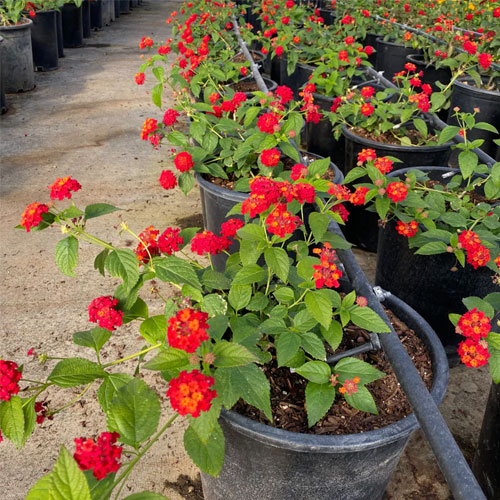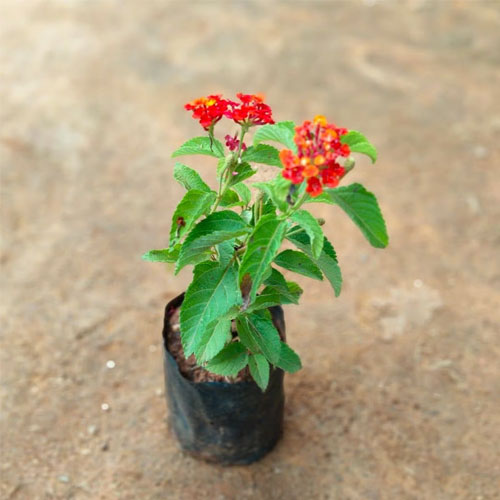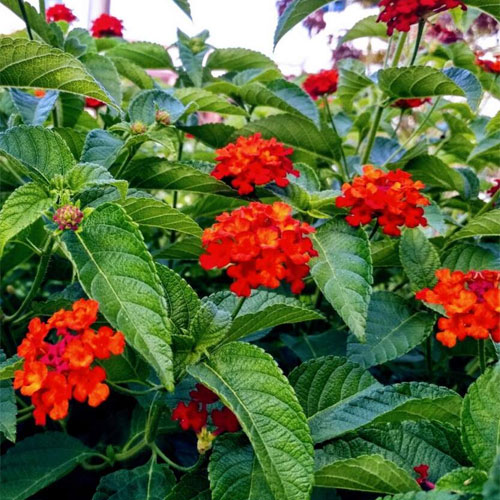Transform your home garden with the vibrant Lantana Red Dwarf Bush Live Plant, a hardy ornamental shrub known for its continuous blooming and eye-catching fire-red flowers. This compact, low-maintenance bush is ideal for edging, ground cover, pots, balcony railings, and pathways. Loved by pollinators like butterflies and bees, this plant thrives even in hot Indian climates.
With its attractive foliage and long-lasting blooms, the Lantana camara (Red Dwarf) adds an evergreen charm to your outdoor or terrace gardens. It requires minimal care and survives even with limited watering, making it one of the best choices for beginner gardeners.
Type of Plant: Ornamental Flowering Shrub – Red Dwarf Lantana
Germination Time: Not applicable (Live Plant)
Hours of Sunlight Needed: 6–8 hours of direct sunlight
Where to Grow: Pots, garden beds, borders, pathways, terraces
Growing Season: Year-round (blooms best in summer to late monsoon)
Seed Sowing Depth: Not applicable
Ideal Climate: Tropical and sub-tropical
Plant Height: Grows up to 1.5–2 feet (delivered as 1-foot plant)
Organic Fertilizer Requirement: Monthly compost or flower booster
Life Span: Perennial
Ideal Growing Temperature: 20°C to 38°C
Blooming Time: Almost year-round; peak in summer
Maintenance Required: Very low
Watering Frequency: Twice a week or when topsoil is dry
Ideal Grow Bag Size: 12×12 or 15×15 inches for healthy root spread



The Lantana Red Dwarf can be grown throughout the year in India, especially in warm climates. Plant it from February to October for maximum blooming. It tolerates summer heat very well and performs best with good sunlight and occasional pruning.
Choose a well-draining large pot or grow bag, and fill it with loamy soil + compost mix. Keep in a location that receives full sun. Water only when the topsoil dries. Use an organic flower fertilizer once a month for more blooms. Prune lightly to maintain bushy shape.
Not applicable – this is a ready-to-grow live plant, not from seed.
Sunlight: Requires full sun for 6+ hours
Soil: Use well-draining loamy or sandy soil
Fertilization: Apply compost or balanced NPK monthly
Pruning: Light pruning helps maintain shape and boost blooming
Support & Spacing: No support required; maintain 1 foot spacing if planting multiple
Pest Control: Use neem spray if aphids or mealybugs appear
Disease Prevention: Ensure good airflow to avoid fungal issues
Mulching: Helps reduce water loss during peak summers
Harvesting: Not edible – flowering ornamental plant only
1. Apply Nutrient-Rich Fertilizers
When your plants begin flowering, use nutrient-rich fertilizers like Organic Bone Meal Powder or Vermicompost. This helps in boosting the bloom and enhances overall yield.
2. Use Organic Fertilizers
Feed your plants with organic fertilizers such as Cow Dung Manure or Neem Cake. Organic options promote healthy soil life.
3. Regular Feeding
Apply fertilizers every 20-25 days to ensure plants receive a steady supply of nutrients. Choose from various options like Cocopeat Compost for
Continuous cluster blooming with bold red flowers
Compact dwarf growth – ideal for edging and containers
Highly drought-tolerant once established
Excellent choice for low-maintenance landscapes
Acts as a butterfly attractor in gardens
Naturally deters some garden pests due to leaf scent
Beautiful for borderlines, rock gardens, and flower beds
Great for balcony pots and terrace gardening
Ideal for public parks, school gardens, and gated communities
Pollinator-friendly – attracts butterflies and bees
Excellent for xeriscaping (low-water landscaping)
Avoid overwatering. Too much shade reduces flowering. The plant may spread if grown directly in ground, so container-growing is ideal. Use gloves when pruning if you have sensitive skin, as leaves may cause minor irritation.
Yellow Leaves: Due to overwatering or poor drainage – fix by improving soil
Leggy Growth: Caused by insufficient sunlight – shift to a brighter area
No Flowers: Likely due to too much shade or lack of pruning – prune and feed compost
Pests: If any, control using organic neem oil spray
Lantana Kempu, Red Lantana Shrub, Kempu Gundu Hoovu, Laal Lantana Ghas, Red Flowering Gundi, Sannakki Soppu, Lantana Red Bush, Dwarf Lantana Plant, Red Shrub Flower Plant, Laal Phool Ghanti, Mini Gundu Pushpam
Q1. Is Lantana Red Dwarf suitable for balconies?
Yes, it thrives in pots on sunny balconies or terraces.
Q2. Can this be grown as ground cover?
Yes. Its compact bushy habit makes it ideal for borders and ground planting.
Q3. Is it fragrant?
No. The attraction lies in its color and long bloom, not fragrance.
Q4. Does it require pruning?
Light pruning helps in keeping it bushy and promotes more flowers.
Q5. Is it safe for pets?
No. Lantana leaves and berries can be toxic if ingested, so keep away from pets.
Sign in now to receive a 5% instant discount on your first order when using code WELCOME. Begin your organic journey today!
By logging in, you're agreeing to our Terms of Service and Privacy Policy.
Krishna Iyer
Bahut acha plant. Garden ke border me lagaya aur full bloom me wow lag raha hai. Recommended! 🌸
Vivek Mehta
Bright red blooms aur healthy leaves ke saath aaya. Low maintenance aur easy to care. 🌿
Pooja Das
Plant thoda chhota tha but survive kar gaya. Water regularly dene se fast growth ho rahi hai.
Manish Pillai
Compact aur easy to grow plant. Pot me lagane ke baad flowering start ho gayi. 🌺
Rohini Singh
Plant thoda delay se mila but healthy tha. Soil moist aur packaging strong thi.
Divya Thomas
Delivery fast thi aur plant healthy. Red blooms ka shine morning sunlight me amazing lagta hai.
Anand Kumar
Golden Hills Farm ka quality hamesha best hota hai. Red lantana ne garden aur colorful bana diya.
Meenal Dey
Beautiful dwarf bush. Compact aur bright flowers ke saath garden ke liye perfect. 💐
Sandeep Nair
Plant thoda small tha but condition excellent thi. Water dene ke baad aur lush ho gaya. 🌿
Tanvi Shah
Red flowers ka color vibrant hai. Delivery time pe aur packaging neat thi.